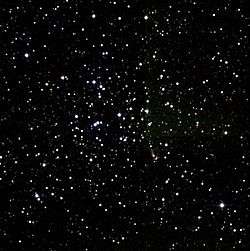Messier 36
Messier 36 or M36, also known as NGC 1960, is an open cluster of stars in the Auriga constellation. It was discovered by Giovanni Batista Hodierna before 1654, who described it as a nebulous patch.[5] The cluster was independently re-discovered by Guillaume Le Gentil in 1749, then Charles Messier observed it in 1764 and added it to his catalogue.[6] M36 is at a distance of about 1,330 pc (4,340 light years) away from Earth.[1] The cluster is very similar to the Pleiades cluster (M45), and if it were the same distance from Earth it would be of similar magnitude.[7]
| Messier 36 | |
|---|---|
 | |
| Observation data (J2000.0 epoch) | |
| Constellation | Auriga |
| Right ascension | 05h 36m 18.0s[1] |
| Declination | +34° 08′ 24″[1] |
| Distance | 4.34 ± 0.87 kly (1.330 ± 0.266 kpc)[1] |
| Apparent magnitude (V) | 6.3 |
| Apparent dimensions (V) | 10′[2] |
| Physical characteristics | |
| Mass | 746+606 −334 M☉[3] M☉ |
| Radius | 7 ly |
| Estimated age | 25.1 Myr[1] |
| Other designations | C 0532+341, M 36, NGC 1960, OCl 445[4] |
This cluster has an angular diameter of 10′[2] and a core radius of 3.2′.[8] It has a mass of roughly 746 M☉ and a linear tidal radius of 10.6±1.6 pc.[3] Based upon photometry, the age of the cluster has been estimated by Wu et al. (2009) as 25.1 Myr[1] and 26.3+3.2
−5.2 Myr by Bell et al. (2013). The luminosity of the stars that have not yet consumed their lithium implies an age of 22±4 Myr, in good agreement these previous estimates.[8]
M36 includes ten stars with a visual magnitude brighter than 10,[8] and 178 down to magnitude 14.[2] 38 members display an infrared excess, with one being particularly high.[9] There is one candidate B-type variable star, which is 9th magnitude.[10]
Map

References
- Wu, Zhen-Yu; et al. (November 2009), "The orbits of open clusters in the Galaxy", Monthly Notices of the Royal Astronomical Society, 399 (4): 2146–2164, arXiv:0909.3737, Bibcode:2009MNRAS.399.2146W, doi:10.1111/j.1365-2966.2009.15416.x.
- Sanner, J.; et al. (May 2000), "Photometric and kinematic studies of open star clusters. II. NGC 1960 (M 36) and NGC 2194", Astronomy and Astrophysics, 357: 471–483, arXiv:astro-ph/0003327, Bibcode:2000A&A...357..471S.
- Piskunov, A. E.; et al. (January 2008), "Tidal radii and masses of open clusters", Astronomy and Astrophysics, 477 (1): 165–172, Bibcode:2008A&A...477..165P, doi:10.1051/0004-6361:20078525.
- "M 36". SIMBAD. Centre de données astronomiques de Strasbourg. Retrieved November 22, 2018.
- Fodera-Serio, G.; et al. (February 1985), "Hodierna's Observations of Nebulae and his Cosmology", Journal for the History of Astronomy, 16 (1): 1, Bibcode:1985JHA....16....1F, doi:10.1177/002182868501600101.
- Stoyan, Ronald; et al. (2008), Atlas of the Messier Objects: Highlights of the Deep Sky, translated by Schroeder, Klaus-Peter, Cambridge University Press, pp. 530–533, ISBN 978-1139473118
- Frommert, Hartmut; Kronberg, Christine (August 25, 2007), "Messier 36", The Messier Catalog, Students for the Exploration and Development of Space (SEDS), retrieved 2018-11-24.
- Jeffries, R. D.; et al. (September 2013), "A lithium depletion boundary age of 22 Myr for NGC 1960", Monthly Notices of the Royal Astronomical Society, 434 (3): 2438–2450, arXiv:1306.6339, Bibcode:2013MNRAS.434.2438J, doi:10.1093/mnras/stt1180.
- Smith, R.; Jeffries, R. D. (March 2012), "Dust discs around intermediate-mass and Sun-like stars in the 16 Myr old NGC 1960 open cluster", Monthly Notices of the Royal Astronomical Society, 420 (4): 2884–2898, arXiv:1110.4219, Bibcode:2012MNRAS.420.2884S, doi:10.1111/j.1365-2966.2011.20032.x.
- Delgado, A. J.; et al. (October 1984), "Search for B-Type Variable Stars in Open Clusters", Information Bulletin on Variable Stars, 2603: 1, Bibcode:1984IBVS.2603....1D.
External links
| Wikimedia Commons has media related to Messier 36. |
- Messier 36 on WikiSky: DSS2, SDSS, GALEX, IRAS, Hydrogen α, X-Ray, Astrophoto, Sky Map, Articles and images
